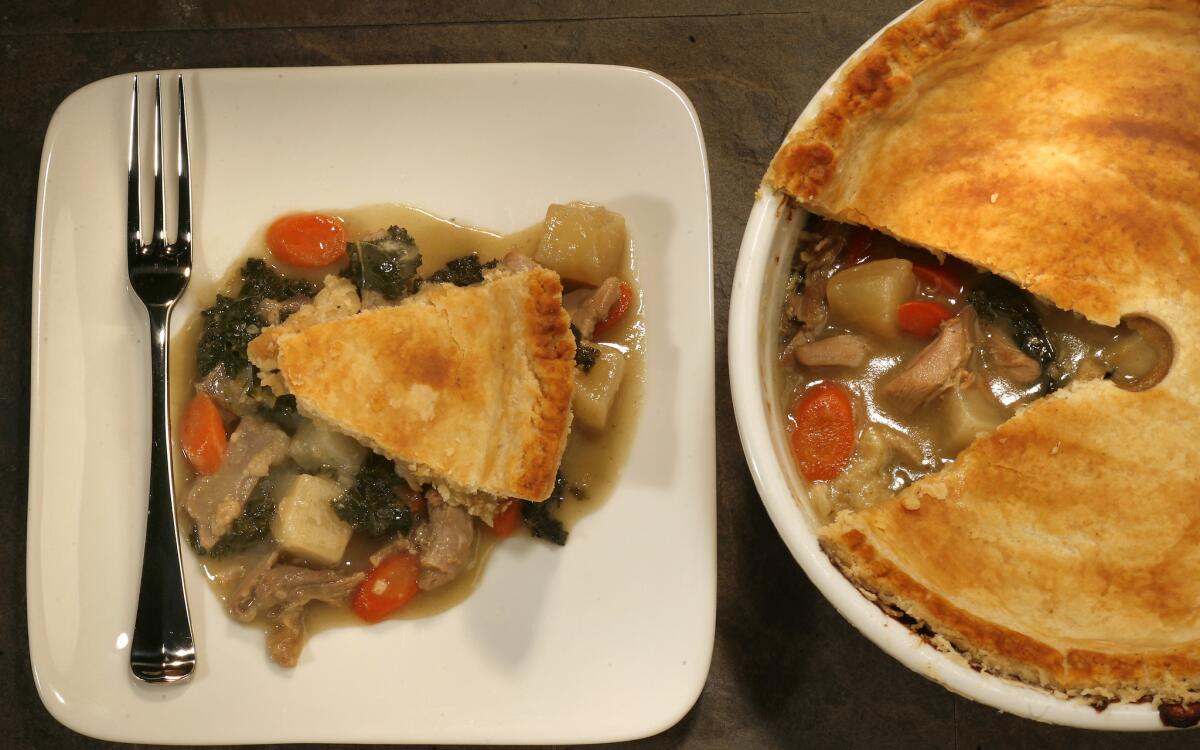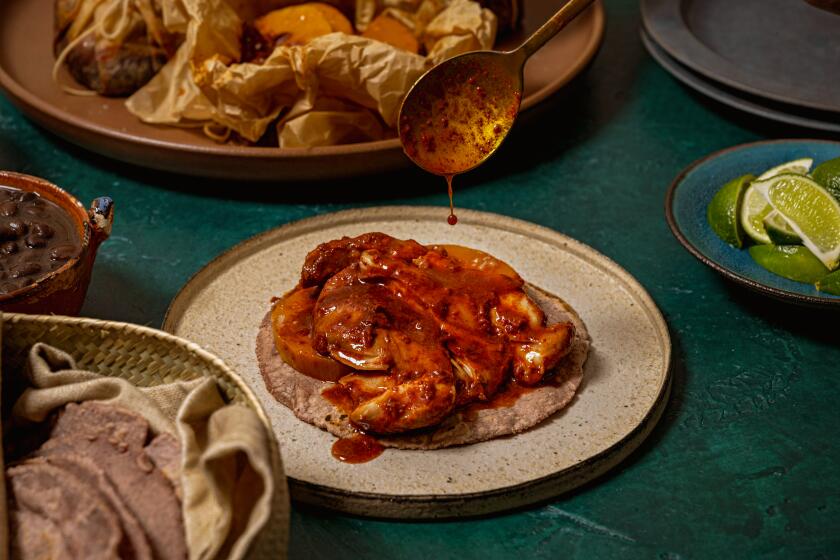Roasted duck pot pie

- Share via
In a winter when Angelenos have seen such sights as a snow plow working the streets of Malibu, it’s no surprise that there’s a revival of interest in warm, rich, delicious pot pie.
It’s what diners tuck into on any given chilly evening at the 2-month-old Rustic Canyon Wine Bar and Seasonal Kitchen in Santa Monica, just 10 blocks from the beach. “We keep making more of them and every night they sell out,” says general manager and co-owner Josh Loeb. “We figured people would love the burger ... but it’s the pot pie” -- a modern, crowd-pleasing root-vegetable pot pie -- that has been a surprise hit.
Each baked-to-order pie, filled with bechamel-coated parsnips, carrots, baby turnips, pearl onions, fingerling potatoes and a bit of baby Swiss chard, is aromatic with thyme and a pinch of nutmeg. The whole thing -- enough for two -- is blanketed with a flaky crust.
Chef Samir Mohajer uses a cream cheese dough for his crust, made with equal parts butter and cream cheese. Butter gives it a melt-in-the-mouth quality, and the cream cheese makes it even more tender and flavorful. It’s a rolled-in dough (like a puff pastry, it’s folded into thirds before it’s rolled), which results in a fluffy, layered crust. “I wouldn’t think of using any other type of crust with this pot pie,” Mohajer says.
The brilliant touch is a wild herb salad that sits atop the pot pie, a tangle of spicy cress that Mohajer picks up from the Coleman Family Farms stand at the Santa Monica farmers market. Also known as upland cress or winter cress, the small, notch-leafed greens are delicate but with a peppery bite, although not quite as pungent as watercress. They’re dressed simply with olive oil and lemon juice, a sprinkling of salt and pepper, and lend a freshness and even a sophistication to the pot pie, a rustic dish suddenly made polished, surprisingly exciting even.
Like the version at Rustic Canyon, pot pies can be thoroughly modern -- and still profoundly satisfying. Update the familiar chicken pot pie with attention-getting ingredients such as chorizo and saffron, crown it with a biscuity cornmeal crust flecked with thyme, and you’ll have a sensational dish still utterly recognizable as chicken pot pie.
As modest as the dish might be, pot pie has appeared on many a high-end menu over the last decade. Thomas Keller’s forest mushroom pot pie is packed with hen-of-the-woods mushrooms and served with matignon of root vegetables. Charlie Trotter has made a version filled with veal and mushrooms. One of Michael Mina’s signature dishes is lobster pot pie made with the meat from a whole lobster under a dome of pastry. And Rustic Canyon’s Loeb says his inspiration for putting a pot pie on the menu was at least partly from a Daniel Boulud recipe he had once come across.
What transforms pot pie into a luxury dish is an investment of some time (a great luxury, of course). A sumptuous duck pot pie with a crust that relies on duck fat doesn’t cut corners, and the result -- tender pieces of duck, turnips, carrots and kale in a delicious saucy stew -- is well worth the considerable effort. Approach making it the same way you might a cassoulet: You could do it all in one day or at a more leisurely pace over two. Roast the duck, render the duck fat (alternatively, you could buy duck fat) and make the stock the first day and then assemble the pie on the second. With duck stock in the sauce and a little duck fat in the roux, it’s something of a duck extravaganza. It’s great for a dinner party, brought to the table in a big casserole and served with a glass of Gigondas.
Perfect for a snowy day in Malibu, or when the temperature dips down into the mid-60s. Brrrrr!
Duck filling
Heat the oven to 425 degrees. Rinse the cavity of the duck well under cold running water until the water runs clear. Set aside all giblets but the liver (discard the liver) for making stock. Pat the duck dry and rub about 1 tablespoon of the olive oil on the outside of the duck. Season with salt.
In a roasting pan, toss the carrots, onion, celery and thyme with the remaining 1 tablespoon olive oil. Place the duck on top of the vegetables; roast for 15 minutes. Reduce the oven temperature to 350 degrees and continue to roast an additional 1 hour to 1 hour, 20 minutes until a thermometer inserted in the thigh reaches 145 degrees. (The meat will be pink.) Remove the duck from the oven and let stand until cool enough to handle.
For the duck fat, strain the roasting juices from the pan and skim the fat from the juices (you should have two-thirds cup fat for the crust). Place it in the freezer until the fat completely solidifies, about 2 hours. Once the roasted duck has cooled, remove skin and fat. Tear the skin into pieces and place it in a heavy-bottomed saucepan. Cook over low heat to render the fat, about 1 1/2 hours. Strain fat and set aside. You’ll need about a one-fourth cup fat for the roux for the filling. If you’re short of fat, you can add butter.
Meanwhile, remove the duck meat from the carcass; set aside the carcass for stock. Shred the meat into bite-size pieces. Cover and set aside.
For the stock, scrape the roasted vegetables along with any drippings into a saucepot. Add the reserved giblets along with the duck carcass from roasting the duck. Add 10 cups water, black peppercorns and 1 teaspoon salt. Bring to a boil. Reduce the heat and simmer about 1 1/2 hours. Skim off the excess fat as the stock cooks. Remove from the heat and strain the stock through a fine mesh strainer. Rinse the saucepot and pour the strained broth back into the pan. Bring to a boil and reduce until the stock measures about 4 cups.
Prepare the vegetables. In a clean pot, blanch the kale in boiling salted water about 1 minute, drain well and set aside. In a saute or frying pan, cook sliced carrots and turnips in 1 tablespoon butter over medium-high heat until just tender, 7 to 8 minutes.
For the roux, heat one-fourth cup duck fat in a small saucepan until hot. Stir or whisk in one-third cup flour and cook, stirring constantly, until smooth and bubbly. Simmer 2 to 3 minutes, then stir the roux into the hot stock. Heat and stir until the sauce is smooth. Bring to a boil over high heat, then reduce to a simmer. Season to taste with salt. Cook until the sauce thickens, about 5 minutes.
Stir the shredded duck along with sauteed vegetables and the kale into the sauce. Cover and keep warm.
Crust and assembly
Heat the oven to 400 degrees. Stir together the flour, salt and black pepper. Quickly cut in the cold duck fat with a pastry cutter or by hand until the fat forms pieces the size of small peas. Add the ice water a tablespoon at a time, tossing with a fork until the dough is moistened and it forms a ball. Shape the dough into a flat disc. The dough will be soft and easy to roll out on a heavily floured surface. Flour the rolling pin as well. (The dough should not be chilled. It will become crumbly and difficult to roll if chilled.)
Lightly roll out the dough on a well-floured surface into an 11-inch circle. (The dough is easy to patch if necessary.) Using a 1-inch round cutter, cut a hole in the center of the dough.
Spoon the hot duck filling into a casserole. Roll the rolled dough partly around a rolling pin and gently lift it onto the top of the dish. Use a fork to seal the crust to the rim of the dish and trim any excess. Brush the pastry with milk. Put the casserole on a foil-lined baking sheet to catch any drips. Bake about 45 minutes until it is golden brown.
Get our Cooking newsletter
Get a taste of Los Angeles — and the world — with recipes and kitchen tricks from the L.A. Times’ Cooking newsletter.
You may occasionally receive promotional content from the Los Angeles Times.
















